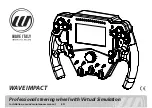
1
MODEL 6127 & 6127XL
KWIKSTART PRO SERIES
OPERATORS MANUAL
SAVE THESE INSTRUCTIONS
This manual contains important safety and operation instructions for the engine starter/battery charger you have purchased. You may need to refer
to these instructions at a later date.
INTRODUCTION
The KwikStart Pro Series is a wheel around starter/charger designed to start and charge 12-volt vehicles/batteries. It has a battery compartment to
house the starting battery and a fully automatic charger to recharge the starting battery quickly, or can be used as a charger to charge other 12-volt
batteries. Because of the internal battery you do not need to be near an AC power source when starting vehicles as you would with a battery
charger.
BATTERY SAFETY
When installing the battery in the unit, starting cars, or charging other batteries, you should be aware of and alert to the hazards of working near the
lead-acid battery. Wear complete eye protection and clothing protection. Avoid touching eyes while working near battery. If battery acid contacts
skin or clothing, wash immediately with soap and water.
IF ACID ENTERS EYE IMMEDIATELY FLOOD EYE WITH RUNNING COLD WATER FOR AT LEAST 10 MINUTES AND SEEK
MEDICAL ATTENTION IMMEDIATELY. NEVER USE EYE DROPS OR OTHER MEDICATION BEFORE SEEING A DOCTOR.
Neutralize spilled acid with a solution of baking soda (1 pound per gallon of cold water) or household ammonia (1 pint per gallon of cold water).
While batteries are being charged, an explosive gas mixture forms inside each cell. Some of this gas escapes through the vent holes in the fill caps
and may remain around the battery in an explosive condition. Sparks or flames igniting this gas mixture will burn back through the vent hole and
explode inside the battery cell. Such an explosion is dangerous not only because of its own force but also because of the battery acid which it could
spray on anything in the vicinity.
TO PREVENT BATTERY EXPLOSION
Be sure that the area around the battery is well ventilated. Do not smoke, cause sparks, or have an open flame near any battery that has recently
been charged or has been used to start a vehicle.
Do not break live electrical circuits at the terminals of batteries. A spark may occur at that point causing an explosion. Always disconnect the clamp
attached to the frame of the vehicle first.
DO NOT BOOST OR CHARGE A FROZEN BATTERY; TRAPPED GASES MAY CAUSE AN EXPLOSION.
DO NOT OPERATE THE UNIT WITHOUT AN INTERNAL BATTERY, THE INTERNAL BATTERY TERMINALS MAY SHORT
AND CAUSE ARCING.
CHOOSING AN INTERNAL BATTERY FOR YOUR UNIT
When choosing a battery for your unit, several factors must be considered.
1.
PHYSICAL SIZE:
The unit will accommodate any of several group sizes of batteries. The maximum dimensions that a
battery may have and still fit are: Model 6127: Length: = 10 ½ ”, Width: = 7”, Height: = 9 ½”
Most Common: Standard Group 24
Model 6127XL: Length: = 13”, Width: = 7”, Height: = 9 ½”
Most Common: Standard Group 31
A battery of these sizes will be readily available from most battery retailers or wholesalers. Your battery salesman can help
you pick a battery of this size or from another group size if you desire.
2.
ELECTRICAL SIZE:
In most cases, the primary function of the battery is to provide power to crank an engine during starting. This
requirement involves a large discharge in amperes over a short span of time. The COLD CRANKING AMPS (CCA) rating of a battery is defined as:
The discharged load in amperes which a new, fully charged battery at 0°F (-17.8°C) can deliver for 30 seconds and maintain a voltage of 1.2 volts
per cell or higher.
If you are going to use your unit as a 12-volt power supply to run trouble lights or other equipment, the RESERVE CAPACITY of a battery will be
your principle concern in choosing a battery. Reserve Capacity is defined as: The number of minutes a new, fully charger battery at 80°F (26.7°C)
can be discharged at 25 amperes and maintain a voltage of 1.75 volts per cell or higher.
The exact size of the battery you choose will depend upon the type of use the unit is subjected to. Factors that should be considered when picking
a battery include:
1.
Number of cars per day to be started.
2.
Size of engines to be started.
3.
Condition of engines to be started.
4.
Ambient temperatures that unit will be used in. (The colder the temperature, the larger the battery required.)
5.
Amount of time between starts.
ASSOCIATED






















